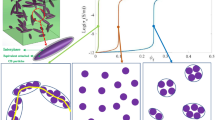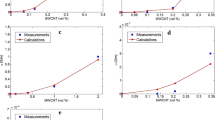Abstract
We present an analytical micromechanical model to predict the electrical conductivity and the percolation behavior of the conductive Polymer nano-composites (PNCs) containing spherical carbon black (CB) nanoparticles as fillers. The proposed model accounts for the effect of quantum electron tunneling, the thickness of the interphase region, the radius of filler, the conductivity of the filler, the conductivity of interphase region, the conductivity of matrix, and volume fraction loading. The characteristics of the interphase layer including those related to the fabrication of the polymer matrix and the type of the nanocomposite employed, quantum electron tunneling, and the conductive network resulting from electrical contacts are the principal physical mechanisms determining the overall electrical conductivity. The model accurately describes the measured electrical conductivity of a variety of nanocomposites over the entire range of CB volume fractions, and accounts for the very sharp transition at the percolation threshold. Notably, the model accurately predicts the wide distribution of experimentally observed percolation thresholds for PNCs reinforced with CB fillers, which lie in the 3-30\(\%\) range.
Graphic Abstract





Similar content being viewed by others
Data Availability Statement
Not applicable
References
Deng, H., Lin, L., Ji, M., Zhang, S., Yang, M., Qiang, F.: Progress on the morphological control of conductive network in conductive polymer composites and the use as electroactive multifunctional materials. Prog. Polym. Sci. 39(4), 627–655 (2014)
Krückel, J., Starỳ, Z., Triebel, C., Schubert, D.W., Münstedt, H.: Conductivity of polymethylmethacrylate filled with carbon black or carbon fibres under oscillatory shear. Polymer 53(2), 395–402, (2012)
Hai-**, X., Dang, Z.M., Yao, S.H., Jiang, M.J., Wang, D.: Exploration of unusual electrical properties in carbon black/binary-polymer nanocomposites. Appl. Phys. Lett. 90(15),(2007)
Pan, Y., Weng, G.J., Meguid, S.A., Bao, W.S., Zhu, Z.-H., Hamouda, A.M.S.: Percolation threshold and electrical conductivity of a two-phase composite containing randomly oriented ellipsoidal inclusions. J. Appl. Phys. 110(12),(2011)
Tian, M., Ma, Q., Li, X., Zhang, L., Nishi, T., Ning, N.: High performance dielectric composites by latex compounding of graphene oxide-encapsulated carbon nanosphere hybrids with xnbr. J. Mat. Chem. A 2(29), 11144–11154 (2014)
Yanfei, X., Wang, Y., Liang, J., Huang, Y., Ma, Y., Wan, X., Chen, Y.: A hybrid material of graphene and poly (3, 4-ethyldioxythiophene) with high conductivity, flexibility, and transparency. Nano Res. 2(4), 343–348 (2009)
Wu, X., Lu, C., Zhang, X., Zhou, Z.: Conductive natural rubber/carbon black nanocomposites via cellulose nanowhisker templated assembly: tailored hierarchical structure leading to synergistic property enhancements. J. Mat. Chem. A 3(25), 13317–13323 (2015)
Alemour, B., Yaacob, M.H., Lim, H.N., Hassan, M.R.: Review of electrical properties of graphene conductive composites. Int. J. Nanoelect. Mat. 11(4), (2018)
Kim, S.Y., Noh, Y.J., Yu, J. Prediction and experimental validation of electrical percolation by applying a modified micromechanics model considering multiple heterogeneous inclusions. Comp. Sci. Tech. 106, 156–162, (2015)
Xue, Q.: The influence of particle shape and size on electric conductivity of metal-polymer composites. Eur. Polymer J. 40(2), 323–327 (2004)
Quintanilla, J.: Measurement of the percolation threshold for fully penetrable disks of different radii. Phys. Rev. E 63(6),(2001)
Li, J., Zhang, S.L.: Finite-size scaling in stick percolation. Phys. Rev. E 80(4),(2009)
Deng, F., Zheng, Q.S., Wang, L.F., Nan, C.W.: Effects of anisotropy, aspect ratio, and nonstraightness of carbon nanotubes on thermal conductivity of carbon nanotube composites. Appl. Phys. Lett. 90(2),(2007)
Hashemi, R., Weng, G.J. A theoretical treatment of graphene nanocomposites with percolation threshold, tunneling-assisted conductivity and microcapacitor effect in ac and dc electrical settings. Carbon 96, 474–490, (2016)
He, B., Mortazavi, B., Zhuang, X., Rabczuk, T.: Modeling kapitza resistance of two-phase composite material. Compos. Struct. 152, 939–946 (2016)
Wang, Y., Weng, G.J., Meguid, S.A., Hamouda, A.M.: A continuum model with a percolation threshold and tunneling-assisted interfacial conductivity for carbon nanotube-based nanocomposites. J. Appl. Phys. 115(19), 193706, (2014)
Xue, Q.Z.: Model for the effective thermal conductivity of carbon nanotube composites. Nanotechnology 17(6), 1655 (2006)
Yan, K.Y., Xue, Q.Z., Zheng, Q.B., Hao, L.Z.: The interface effect of the effective electrical conductivity of carbon nanotube composites. Nanotechnology 18(25),(2007)
Kirkpatrick, S.: Percolation and conduction. Rev. Mod. Phys. 45(4), 574 (1973)
Stauffer, D.: Scaling theory of percolation clusters. Phys. Rep. 54(1), 1–74 (1979)
Zallen, R.: The physics of amorphous solids. John Wiley & Sons, (2008)
Taherian, R.: Experimental and analytical model for the electrical conductivity of polymer-based nanocomposites. Compos. Sci. Technol. 123, 17–31 (2016)
Bruggeman, V.D.A.G.: Berechnung verschiedener physikalischer konstanten von heterogenen substanzen. i. dielektrizitätskonstanten und leitfähigkeiten der mischkörper aus isotropen substanzen. Annalen der physik 416(7), 636–664 (1935)
Landauer, R.: The electrical resistance of binary metallic mixtures. J. Appl. Phys. 23(7), 779–784 (1952)
Mazaheri, M., Payandehpeyman, J., Khamehchi, M.: A developed theoretical model for effective electrical conductivity and percolation behavior of polymer-graphene nanocomposites with various exfoliated filleted nanoplatelets. Carbon 169, 264–275 (2020)
Noh, Y.J., Joh, H.I., Yu, J., Hwang, S.H., Lee, S., Lee, C.H., Kim, S.Y., Youn, J.R.: Ultra-high dispersion of graphene in polymer composite via solvent free fabrication and functionalization. Sci. Rep. 5, 9141, (2015)
Payandehpeyman, J., Mazaheri, M., Khamehchi, M.: Prediction of electrical conductivity of polymer-graphene nanocomposites by develo** an analytical model considering interphase, tunneling and geometry effects. Composites Comm. page 100364, (2020)
Wang, G., Wang, C., Tang, C., Zhang, F., Sun, T., **aozhu, Y.: Two-stage electrical percolation of metal nanoparticle-polymer nanocomposites. J. Phys. Chem. C 122(15), 8614–8620 (2018)
Taherian, R.: Development of an equation to model electrical conductivity of polymer-based carbon nanocomposites. ECS J. Solid State Sci. Tech. 3(6), M26 (2014)
Feng, C., Jiang, L.: Micromechanics modeling of the electrical conductivity of carbon nanotube (cnt)-polymer nanocomposites. Compos. A Appl. Sci. Manuf. 47, 143–149 (2013)
Griffiths, D.J.: Introduction to electrodynamics, (2005)
Geim, A.K., Novoselov, K.S.: The rise of graphene. In Nanoscience and technology: a collection of reviews from nature journals. World Sci. 11–19, (2010)
Jackson, J.D.: Classical electrodynamics (1999)
Qingzhong, X.: Effective-medium theory for two-phase random composites with an interfacial shell. Cailiao Kexue Yu Jishu (J. Mat. Sci. Tech.)(China)(USA) 16, 367–369, (2000)
Wang, L., Peng, W., Sarafbidabad, M., Zare, Y.: Explanation of main tunneling mechanism in electrical conductivity of polymer/carbon nanotubes nanocomposites by interphase percolation. Polym. Bull. 76(11), 5717–5731 (2019)
Simmons, J.G.: Generalized formula for the electric tunnel effect between similar electrodes separated by a thin insulating film. J. Appl. Phys. 34(6), 1793–1803, (1963)
Manta, A., Gresil, M., Soutis, C.: Predictive model of graphene based polymer nanocomposites: electrical performance. Appl. Compos. Mater. 24(2), 281–300 (2017)
**aoxin, L., Yvonnet, J., Detrez, F., Bai, J.: Multiscale modeling of nonlinear electric conductivity in graphene-reinforced nanocomposites taking into account tunnelling effect. J. Comput. Phys. 337, 116–131 (2017)
Kim, D.W., Lim, J.H., Yu, J.: Efficient prediction of the electrical conductivity and percolation threshold of nanocomposite containing spherical particles with three-dimensional random representative volume elements by random filler removal. Composites Part B: Engineering, 168, 387–397, (2019)
Aribou, N., Nioua, Y., Bouknaitir, I., El Hasnaoui, M., Achour, M.E., Costa, L.C.: Prediction of filler/matrix interphase effects on ac and dc electrical properties of carbon reinforced polymer composites. Polym. Compos. 40(1), 346–352 (2019)
Soto, F.A., Ma, Y., de la Hoz, J.M.M, Seminario, J.M, Balbuena, P.B.: Formation and growth mechanisms of solid-electrolyte interphase layers in rechargeable batteries. Chem. Mat. 27(23), 7990–8000 (2015)
Choi, H.J., Kim, M.S., Ahn, D., Yeo, S.Y., Lee, S.: Electrical percolation threshold of carbon black in a polymer matrix and its application to antistatic fibre. Sci. Rep. 9(1), 1–12, (2019)
Rebeque, P.V., Silva, M.J., Cena, C.R., Nagashima, H.N, Malmonge, J.A., Kanda, D.H.F.: Analysis of the electrical conduction in percolative nanocomposites based on castor-oil polyurethane with carbon black and activated carbon nanopowder. Polymer Composites 40(1) 7–15, (2019)
Acknowledgements
Not applicable
Funding
Not applicable
Author information
Authors and Affiliations
Contributions
Mojtaba Mazaheri: (1/3) Theory, Conceptualization, Original draft preparation, and Writing; Javad Payandehpeyman: (1/3) Theory, Conceptualization, Methodology, Programming, Validation, and Writing; Shahriar Jamasb: (1/3) Conceptualization, Validation, Writing, Reviewing and Editing
Corresponding author
Ethics declarations
Consent for Publication
Not applicable
Ethics Approval and Consent to Participate
Not applicable
Competing Interests
The authors declare that they have no competing interests.
Adherence to National and International Regulations
Not applicable
Additional information
Publisher’s Note
Springer Nature remains neutral with regard to jurisdictional claims in published maps and institutional affiliations.
Rights and permissions
About this article
Cite this article
Mazaheri, M., Payandehpeyman, J. & Jamasb, S. Modeling of Effective Electrical Conductivity and Percolation Behavior in Conductive-Polymer Nanocomposites Reinforced with Spherical Carbon Black. Appl Compos Mater 29, 695–710 (2022). https://doi.org/10.1007/s10443-021-09991-y
Received:
Accepted:
Published:
Issue Date:
DOI: https://doi.org/10.1007/s10443-021-09991-y




